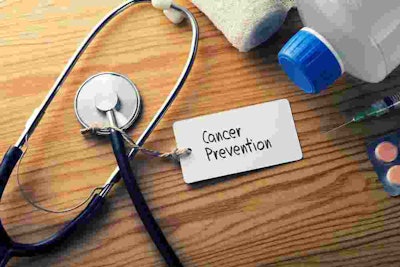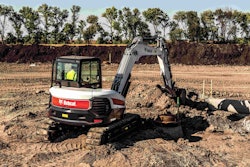
Cancer can strike without warning, and it can leave individuals wondering how and why. While there’s no cut and dry answer for every case, many times the daily circumstances a person experiences can prove to be causing the problem.
According to research performed by CCS Oncology, the five most common types of cancer are breast cancer, lung cancer, prostate cancer, colon and rectal cancer and melanoma. Of these five, the one most commonly seen affecting green industry professionals is melanoma and other forms of skin cancer.
It’s commonly stated that awareness is one of the best methods of prevention for cancer. By taking a look at some of the common causes of cancer and the symptoms that can accompany it, the chances of diagnosing someone early and seeking early treatment becomes greater.
Common causes and symptoms of cancer
The Mayo Clinic says that the word cancer refers to any one of a large number of diseases characterized by the development of abnormal cells that divide uncontrollably and have the ability to infiltrate and destroy normal body tissue. It often has the ability to spread throughout the entire body, and it is the second-leading cause of death in the United States.
Cancer is caused by mutations or changes in the DNA within the cells. These gene mutations, according to the Mayo Clinic, can allow cells to grow and divide more rapidly, which in turn creates new cells with the same mutation present.
Gene mutations can also fail to stop cell growth, which then allows cancer cells to continue their growth and accumulate. These mutations also make mistakes when repairing errors in DNA. Repair genes in DNA look for errors in the DNA of a cell to make corrections, and a mutation in this repair gene could mean errors go uncorrected, which can lead to cells becoming cancerous.
Individuals can be born with mutations because of genes inherited from parents, which the Mayo Clinic says only accounts for a small percentage of cancers. Mutations that occur after birth that are not inherited can be caused by a number of forces, such as smoking, radiation, viruses, cancer-causing chemicals (carcinogens), obesity, hormones, chronic inflammation and a lack of exercise.
The Mayo Clinic says gene mutations occur frequently during normal cell growth, and even though cells contain a mechanism that recognizes and fixes mistakes, mistakes do get missed. This causes cells to become cancerous.
Depending on the area of the body affected by cancer, symptoms will vary, but there are a few general signs that can be associated with, but are not specific to, cancer to keep an eye out for. The Mayo Clinic lists them as follows:
- Fatigue
- Lump or area of thickening that can be felt under the skin
- Weight changes, including unintended loss or gain
- Skin changes, such as yellowing, darkening or redness of the skin, sores that won’t heal or changes to existing moles
- Changes in bowel or bladder habits
- A persistent cough or trouble breathing
- Difficulty swallowing
- Hoarseness
- Persistent indigestion or discomfort after eating
- Persistent, unexplained muscle or joint pain
- Persistent, unexplained fevers or night sweats
- Unexplained bleeding or bruising
If these symptoms persist, the Mayo Clinic recommends seeking the opinion of a medical professional. If there is a history of cancer in your family or you are concerned for other reasons, but you are not currently showing symptoms, discuss the option of early screening tests and appropriate procedures for you.
Melanoma and other skin cancers
As stated earlier, the most common cancers that affect those in the green industry are melanoma and other types of skin cancer.
According to the Skin Cancer Foundation, skin cancer is defined as the uncontrolled growth of abnormal skin cells, and it can occur when unrepaired DNA damage to the skin cells triggers mutations. This will lead the skin cells to rapidly multiply and form malignant tumors.
Melanoma, according to the Melanoma Research Foundation (MRF), is usually, but not always, a cancer of the skin. Melanoma begins in melanocytes, which are the cells that produce the pigment melanin that gives color to the skin, eyes and hair, and also forms moles.
There are three types of melanoma: cutaneous, mucosal and ocular. For those out and about in the harsh rays of the sun, cutaneous is the type many may, unfortunately, become acquainted with. Cutaneous melanoma occurs on the skin, and since most pigment cells are found in the skin, this is the most common type of melanoma.
Since melanoma can be more easily seen and detected than other forms of cancer, it is easier to treat in the early stages before spreading to the rest of the body.
For more information on the different types of skin cancers and precancers, click here.
Risk factors
While doctors may not have the absolute reasoning behind the causes of cancer, there are many known risk factors that the Mayo Clinic says may increase an individual’s risk of cancer.
Age: Cancer can sometimes take many years to develop; this is why the vast majority of people diagnosed are over the age of 65, according to the Mayo Clinic. Even though cancer is more common in older adults, this does not mean it is an exclusively adult disease. Cancer can be diagnosed at any age, so be sure to seek professional medical advice for any concerns.
Habits and health: Certain lifestyle choices, such as smoking, excessive drinking, excessive sun exposure, obesity and more, can contribute to a person’s risk of cancer. By altering these habits, the Mayo Clinic says the risk of getting cancer can be lowered. Some health conditions that are chronic can also contribute to a person’s likelihood of having cancer.
Family history: Not every factor is one that can be controlled, but the Mayo Clinic reports that only a small portion of cancers are due to an inherited condition. The risk of having an inherited cancer gene increases if cancer is prominent and common in a family, but genetic testing is available for those who think they may carry inherited mutations. Keep in mind that even if the inherited gene is present, a person still may never actually get cancer.
Environment: A person’s environment can contain many harmful chemicals that can increase the risk of cancer, such as secondhand smoke or chemicals in the home or workplace. Even those who practice healthy lifestyles can be affected by the environment they live in.
Prevention
According to the MRF, 90 percent of melanoma cases can be linked to exposure to ultraviolet (UV) rays from natural or artificial sources, which means that practicing effective prevention tips is crucial for landscapers who find themselves constantly in the sun.
When it comes to melanoma prevention, the MRF recommends the following practices:
- Reduce and limit the amount of UV exposure, both natural and artificial
- Apply sunscreen generously to all exposed skin year-round, even on cloudy days
- Wear protective clothing, such as long-sleeved shirts, pants, sunglasses and wide-brimmed hats
- Stay in the shade when possible
- Exercise more precautions when working near reflective surfaces and environments, such as snow and sand
- Avoid getting sunburns, even if it’s only once in a while
- Avoid intentional tanning, outdoors or in a tanning bed
- Get a good dose of vitamin D
- Know your medications, as some can increase the sensitivity of skin
- Examine skin frequently for signs of melanoma, whether it’s a self-examination or done by a dermatologist
For more facts and statistics on melanoma, click here.
 Photo: Melanoma Research Foundation
Photo: Melanoma Research Foundation










